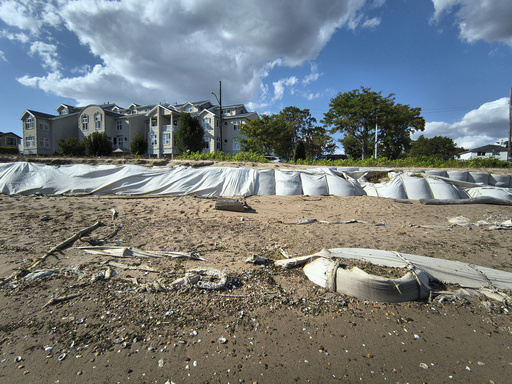
NEW YORK — The fierce waves that lashed against the Tottenville area of Staten Island during Superstorm Sandy twelve years ago wreaked havoc on coastal homes, uprooting properties and drowning residents, including a young girl and her father. With only a thin barrier of sand and a few trees to buffer the impact, the storm’s destructive force was almost unstoppable.
However, after extensive planning and construction, a new artificial reef system was launched this summer to help mitigate the effects of future storms. Funded by $111 million in recovery funds from Sandy, the “Living Breakwaters” designed to be positioned approximately 1,000 feet off the shores of Tottenville aim to provide a protective measure for local residents against the fury of impending hurricanes. While these barriers won’t entirely eliminate flooding risks, project designers assert that they will effectively diminish the intensity of ocean waves, which will contribute to less erosion and lower damage during future weather events.
The artificial reefs not only focus on storm protection but also seek to restore the bay ecosystem that has suffered from pollution, overfishing, and dredging over the years. By incorporating living elements such as tidepools and diverse textures into the design, the structure aims to create habitats for marine life, fostering the growth of oysters, crabs, and fish.
Other coastal cities have taken notice of this innovative approach, with locations like Florida’s Cedar Key, struck recently by Hurricane Helene, considering similar projects. Architect Pippa Brashear, who was instrumental in the Living Breakwaters design, expressed that communities facing waves and erosion might adopt comparable strategies. Some regions in California, Washington State, and Florida are already exploring smaller-scale versions of such habitat-friendly installations.
The Staten Island reefs offer types of storm deterrence akin to traditional breakwaters used in harbors globally. However, many standard seawalls can deter marine life due to their smooth, often unattractive surfaces for creatures like mussels and barnacles. In contrast, the design of New York’s reefs intends to foster a supportive environment for marine species, introducing spaces for juvenile fish and other organisms to thrive.
The islands have quickly begun attracting various bird species for nesting and have even served as a winter haven for migrating seals since construction commenced in 2022. Visible transformations can be seen with algae covering the rocky surfaces and snails, barnacles, and crabs populating the concrete tidepools, which were meticulously placed throughout the area. Plans are also in motion for The Billion Oyster Project to replenish the bay with oysters, which once thrived in Raritan Bay, effective at storm mitigation and water filtration.
The design was developed through a competitive process for Hurricane Sandy relief money in collaboration with the local community. Similar tidepool habitats have been constructed along the San Diego coastline, enriching both the marine ecosystem and the shoreline.
Moreover, a $400 million sea wall featuring living elements has enhanced the Seattle coastline since 2017 while successfully aiding juvenile salmon populations. The funding success of New York’s Living Breakwaters has sparked interest in similar endeavors elsewhere, according to Joshua Norman, who leads disaster resilience initiatives at Trilon Group’s DMRP engineering division. He noted that a similar project in Cedar Key could have helped avoid local erosion during Hurricane Helene.
In the aftermath of Sandy, which claimed 23 lives in Staten Island when it made landfall on October 29, 2012, substantial flooding occurred, devastating numerous homes and neighborhoods. Since then, Staten Island has emerged as a testing ground for innovative responses to storm-related challenges. Some homeowners opted for buyouts, choosing to permanently leave flood-prone areas, while plans for a $600 million seawall, extending five miles and standing 21 feet tall, are set to begin construction soon. Meanwhile, other parts of New York City are bolstering their coastal defenses, with Manhattan planning elevated parkland along the East River that will act as a storm surge barrier and fortified boardwalks being rebuilt on the Rockaway Peninsula.
Experts in climate resilience emphasize that while breakwaters function effectively against severe storms, their utility will fade if sea levels continue to rise. “They provide some temporary respite,” stated Larissa Naylor, a professor specializing in geomorphology and environmental geography at the University of Glasgow.
In Tottenville, although the breakwaters don’t convey the same feeling of security as traditional seawalls, residents who were involved in the planning did not desire structures that would obstruct their view or access to the beach. Yet, some locals remain doubtful about the effectiveness of the breakwaters against powerful storms like Sandy. Resident Michele Heerlein shared her concerns, acknowledging, “If another storm hits, I’m not sure they’ll make a difference.” However, she noted an increase in marine life, mentioning, “More stingrays, sharks, and fish have returned since the breakwaters were installed. They might even help bring back clams and mussels.”
